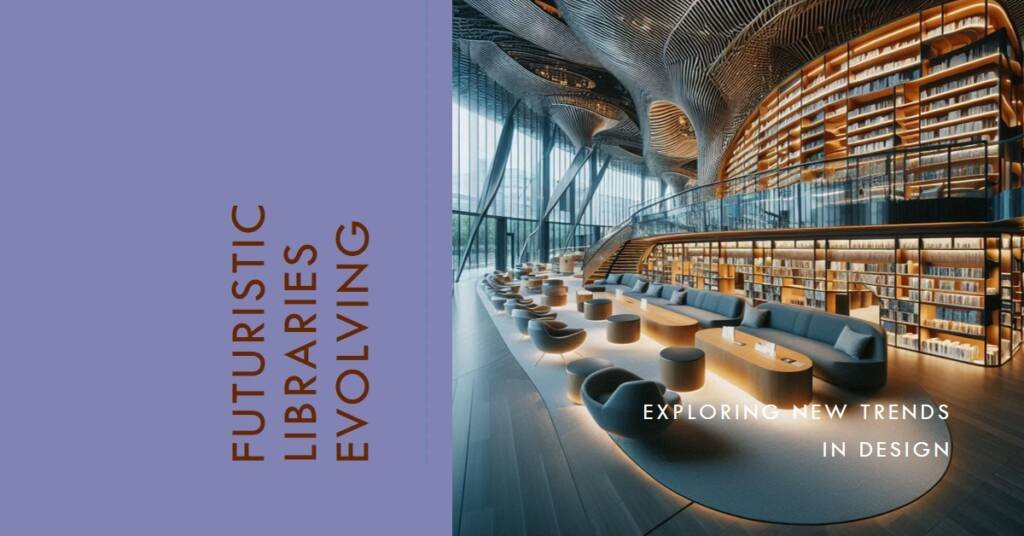
Table of Contents
- Introduction to the Evolution of Libraries
- Emerging Trends in Library Design
- Technology Integration in Libraries
- Libraries as Community Hubs
- The Role of Libraries in Lifelong Learning
- Environmental Sustainability in Library Design
- The Future of Library Services
- Case Studies of Innovative Libraries
- Challenges and Considerations for Libraries
Introduction to the Evolution of Libraries
The traditional perception of libraries often centers around their image as quiet sanctuaries filled with books, where visitors engage in solitary reading or studying. However, the evolution of libraries has seen them transition from simple repositories of knowledge to vibrant, dynamic community hubs. This transformation reflects changing societal needs, technological advancements, and the growing desire for interactive public spaces.
Historically, libraries were established primarily to house collections of books and manuscripts, serving as important centers for education and intellectual growth. The ancient Library of Alexandria exemplifies this traditional role, known for preserving extensive literary works and attracting scholars from various cultures. Fast forward to the 21st century, and the vision of libraries has evolved significantly. As society increasingly values access to information and collaboration, contemporary libraries have expanded their functions to accommodate diverse community needs, showcasing their potential as futuristic libraries.
Modern public libraries are now designed to foster creativity and social interaction, providing spaces for workshops, exhibitions, and community events. Many libraries have adapted to the digital age by integrating technology, offering access to digital resources, and hosting coding classes or digital literacy workshops, thus making them relevant to today’s tech-savvy populace. Furthermore, libraries are increasingly focusing on sustainability and inclusivity, incorporating green designs and accessible facilities. This shift signifies the role of libraries as not just places to borrow books, but as essential public spaces that reflect the evolving dynamics of community engagement, learning, and cultural exchange.
The ongoing innovations in library design and functionality imply that futuristic libraries will continue to evolve, fundamentally altering how society interacts with knowledge and information. By recognizing the historical journey of libraries, we can better appreciate their current role and anticipate the future trends that will shape these vital institutions.
Emerging Trends in Library Design
As libraries evolve to keep pace with the changing needs of their communities, several emerging trends in library design have begun to reshape these public spaces. Modern libraries are increasingly embracing open spaces that encourage collaboration and foster a sense of community among patrons. The traditional layout of isolated book stacks is being replaced by flexible configurations that promote interaction, learning, and creativity. This shift not only enhances user experience but also accommodates diverse activities ranging from group study sessions to workshops and cultural events.
Another significant trend is the incorporation of natural light into library design. Large windows, skylights, and open atriums allow sunlight to flow into the interior, creating a bright and inviting atmosphere. This connection to the outdoors is beneficial for patrons, enhancing their comfort and well-being while encouraging them to spend more time in the space. In addition, natural light reduces dependence on artificial lighting, ultimately contributing to energy efficiency—a crucial aspect of sustainable architecture.
Sustainability is a core principle driving new architectural designs for futuristic libraries. Many libraries are opting for eco-friendly materials, such as reclaimed wood, recycled metal, and low-impact building systems. This commitment to sustainability not only minimizes the ecological footprint of the library buildings but also serves as a model for environmental responsibility within the community. Moreover, the integration of green roofs and energy-efficient systems further aligns library design with contemporary eco-conscious trends.
Technology also plays a pivotal role in shaping the modern library experience. Libraries are increasingly incorporating advanced technologies, including interactive displays, virtual reality stations, and self-checkout systems. These technological enhancements engage patrons in innovative ways, making libraries more appealing to a broader audience, including younger generations. By blending cutting-edge technology with thoughtful design, futuristic libraries are well-positioned to adapt to the demands of future users.
Technology Integration in Libraries
The evolution of libraries has transcended the conventional notions of bookshelves filled with printed literature. In recent years, the integration of advanced technologies has been pivotal in transforming these public spaces into futuristic libraries, catering to the diverse needs of modern users. One of the most compelling additions includes virtual reality (VR) and augmented reality (AR) tools, which allow patrons to engage with information in immersive ways. For example, users can explore historical landmarks or simulate scientific phenomena, enriching their learning experience beyond mere reading.
Furthermore, artificial intelligence (AI) has begun to play a significant role in personalizing user experiences within library environments. By leveraging AI algorithms, libraries can recommend books and resources tailored to individual preferences and reading histories. This technology also streamlines cataloging processes, making it easier for patrons to locate materials using intuitive search features. The shift from traditional card catalogs to user-friendly digital platforms illustrates how libraries are embracing innovation to enhance access to information.
In addition to these technologies, interactive kiosks and information desks have emerged, providing users with immediate assistance and access to digital resources. These kiosks are designed to expedite the borrowing process, allowing patrons to check out books and materials with ease. Moreover, many libraries now offer digital resources—including eBooks, audiobooks, and streaming services—expanding the variety of content that patrons can engage with, regardless of their physical location.
Overall, the adaptation of futuristic technologies in libraries represents a crucial shift towards creating dynamic community spaces. By evolving alongside technological advancements, libraries are not only preserving their core mission to provide knowledge but are also redefining how individuals interact with information in the 21st century.
Libraries as Community Hubs
The evolution of libraries into community hubs marks a significant shift in their traditional function as mere repositories of books. Modern libraries are now designed to serve as dynamic public spaces that encourage interaction, collaboration, and inclusivity. This transformation aligns with the concept of futuristic libraries, which seek to meet the diverse needs of the community while fostering a sense of belonging among its members.
These contemporary libraries frequently offer a wide range of programs and services beyond lending books. Community workshops, cultural events, and educational programs are common features that not only attract different demographics but also facilitate lifelong learning. For example, technology classes geared toward all age groups help bridge the digital divide, enabling individuals to improve their technical skills and adapt to an increasingly digital world.
Moreover, libraries are increasingly recognized as accessible venues for community gatherings. By providing meeting spaces for local organizations, clubs, and social groups, they create an environment that encourages civic engagement and collaboration. This aspect of futuristic libraries highlights their pivotal role in supporting grassroots movements and initiatives, making them vital components of the social infrastructure.
Inclusivity is another crucial component of modern library initiatives. By offering diverse programming that reflects the interests and needs of the community, libraries promote a welcoming atmosphere for everyone. Dedicated spaces for children, teens, and marginalized groups ensure that all voices are heard and represented. Additionally, multi-lingual resources and cultural events empower communities to celebrate their unique heritages while fostering understanding and connection among different cultures.
In essence, libraries have evolved into vibrant community centers where citizens can interact, share knowledge, and grow together. As these futuristic libraries continue to adapt to the changing landscape of public engagement, their potential to shape and strengthen communities remains immense.
The Role of Libraries in Lifelong Learning
In today’s rapidly changing world, the concept of lifelong learning has gained significant importance, particularly within the framework of futuristic libraries. As essential community hubs, libraries have evolved beyond traditional roles, positioning themselves as pivotal players in supporting continuous education and personal development. They have increasingly integrated technology and innovative resources to facilitate access to information and skill enhancement for individuals of all ages.
Futuristic libraries are embracing digital learning platforms that allow patrons to explore various subjects at their own pace. These platforms often include e-books, online courses, and video tutorials on diverse topics, ensuring that users can tailor their learning experiences to fit their personal interests and needs. Moreover, many libraries are offering virtual and in-person workshops and seminars that cover essential skills such as digital literacy, financial management, and professional development, addressing the demands of a modern workforce.
Additionally, libraries are fostering collaborative learning environments that encourage active participation and knowledge sharing among community members. Creative spaces equipped with modern technology enable users to engage in group projects, discuss ideas, and provide feedback. These areas facilitate collaborative learning and enhance the collective ability to adapt to emerging trends and technologies. By nurturing an atmosphere of exploration and discovery, libraries are effectively promoting lifelong learning and empowering individuals to take charge of their educational journeys.
As the landscape of learning continues to evolve, the role of futuristic libraries remains crucial. They not only provide access to critical resources but also cultivate a culture of knowledge, inclusivity, and empowerment within their communities. This transformation underscores the libraries’ commitment to lifelong learning, ensuring everyone can benefit from the wealth of information at their disposal.
Environmental Sustainability in Library Design
In recent years, the concept of futuristic libraries has evolved to incorporate a strong emphasis on environmental sustainability. Libraries worldwide are increasingly recognizing their role as community leaders in promoting eco-friendly practices and addressing climate change through innovative design and architecture. By employing sustainable building practices, many libraries are setting a standard for how public spaces can integrate environmental considerations into their frameworks.
One of the primary approaches libraries are taking towards sustainability is the adoption of eco-friendly building materials. These materials often include recycled products, low VOC (volatile organic compounds) paints, and sustainable timber sourced from responsibly managed forests. Not only do these materials reduce the carbon footprint of library construction, but they also contribute to healthier indoor environments for both patrons and staff. Moreover, as part of their commitment to green architecture, many libraries are utilizing energy-efficient designs that prioritize natural light and ventilation, significantly decreasing reliance on artificial lighting and heating systems.
The integration of green technologies further underscores the role of libraries as advocates for sustainability. Many futuristic libraries are equipping their buildings with solar panels, rainwater harvesting systems, and green roofs, allowing them to generate their own power and manage water effectively. Such installations not only enhance the operational efficiency of libraries but also serve as educational tools, demonstrating sustainable practices to the community. In addition, libraries are increasingly adopting smart technologies for energy management, enabling them to monitor and optimize operational performance continually.
Ultimately, as more libraries embrace these sustainable principles, they are redefining their spaces to become proactive leaders in environmental stewardship. This commitment not only benefits the planet but also serves as a guiding example for other public institutions to follow, emphasizing the importance of responsible design in today’s rapidly changing world.
The Future of Library Services
As we envision the future of library services, it is essential to recognize how these public spaces are poised to transform in response to technological advancements and evolving societal needs. One prominent trend is the likely expansion of remote access initiatives. This shift will enable patrons to connect with library resources anytime and anywhere, minimizing the constraints imposed by geographical boundaries. Libraries will increasingly offer extensive digital collections, including e-books, audiobooks, online databases, and even virtual reality experiences that will attract a diverse range of users.
Moreover, the integration of artificial intelligence (AI) and data analytics will enhance personalized experiences within futuristic libraries. By understanding user preferences and reading habits, libraries can recommend tailored content that enriches the experience of each visitor. These advances equip libraries to be more responsive to individual needs, making information access more intuitive and effective.
Community programming is another area where libraries will adapt to reflect contemporary issues and social dynamics. Expect libraries to curate programs that offer workshops on digital literacy, coding, and other skills relevant to today’s job market. Additionally, as social interactions continue to evolve, libraries may become essential hubs for discussions on pressing issues, encouraging civic engagement and community dialogue. This shift towards community-centric programming will reaffirm libraries’ role as safe spaces, fostering connections among diverse groups while addressing local challenges.
In conclusion, the future of library services is undeniably exciting, with futuristic libraries transitioning into multifaceted hubs of knowledge that cater to the needs of their communities. By embracing technological innovations and prioritizing inclusiveness, libraries are positioned to remain vital resources that evolve alongside society.
Case Studies of Innovative Libraries
As communities strive to adapt their public spaces to meet contemporary needs, several pioneering libraries around the globe stand out as embodiments of the concept of futuristic libraries. These institutions are redefining the traditional library experience by incorporating technology, design, and community engagement into their service models.
One notable example is the Helsinki Central Library Oodi in Finland. Opened in 2018, Oodi exemplifies a modern library space, incorporating areas for creative work, meeting rooms, and even a cinema. This library is not merely a repository for books; it is a vibrant community hub that fosters creativity and collaboration. The design emphasizes open spaces flooded with natural light, allowing for a seamless integration of nature and technology. Visitors can engage in various activities ranging from 3D printing to attending workshops, showcasing how futuristic libraries can facilitate lifelong learning.
Another prime example is the Calgary Public Library in Canada, which was unveiled in 2018. The library’s architectural design is striking and inviting, featuring a unique wooden ‘shelving’ element that draws visitors inside. More than just an information center, it houses collaborative workspaces, cultural programming, and even a recording studio, making it a multifunctional space that supports diverse community needs. The integration of public art and technology within its walls further emphasizes the library’s role as a dynamic and innovative environment.
Additionally, the San Francisco Public Library has embarked on a digital transformation that fosters accessibility and interactivity. Through initiatives like mobile apps for borrowing eBooks and online resources, the library aims to cater to a broader audience by bridging digital divides. This approach reflects a growing trend among futuristic libraries to enhance user experience through innovative technology.
These case studies illustrate the ongoing evolution of libraries into versatile public spaces that not only preserve knowledge but also foster community engagement and cultural exchange. As more libraries adopt similar innovative concepts, the future of public reading spaces looks promising, proving that they can adapt effectively to new trends and community expectations.


Challenges and Considerations for Libraries
The evolution of futuristic libraries presents various challenges that public spaces must navigate to adapt to emerging trends. A key issue is funding constraints. Many libraries operate with limited budgets, making it difficult to invest in innovative technologies or refurbishments that create welcoming and multifunctional spaces. Public funding often falls short of the growing demands for modern amenities that cater to a diverse community. Librarians and policymakers must explore creative solutions for fundraising, including partnerships with local businesses or organizations, to support the advancement of their facilities.
Resistance to change is another prominent challenge. Libraries are traditionally viewed as quiet retreat spaces for study and research. This perception can create pushback against initiatives that embrace more interactive or technologically-driven environments. Librarians play a crucial role in facilitating this transition by promoting the benefits of adapting library spaces to meet contemporary needs. They must actively engage patrons in discussions to foster a culture of innovation and openness to change, highlighting the relevance of futuristic libraries in an increasingly digital world.
The digital divide further complicates the picture. While technology integration can enhance library offerings, it runs the risk of alienating those without access to digital resources or skills. This gap emphasizes the necessity for libraries to provide support programs, including workshops and resources that equip patrons with essential digital literacy. By addressing these challenges, library professionals can ensure that futuristic libraries remain inclusive and accessible to all members of the community, bridging the divide and fostering an informed population.
In conclusion, while the transformation of public libraries into futuristic spaces faces hurdles such as funding, resistance to change, and the digital divide, there are ample opportunities for librarians and policymakers to address these issues and promote inclusivity and innovation.



